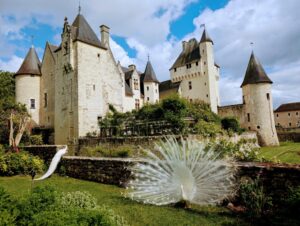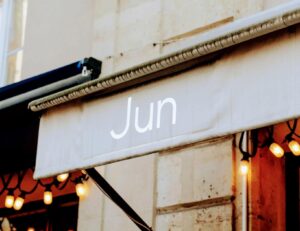Wet your lips in a Calvados glass, a typical Made In Normandy eau-de-vie
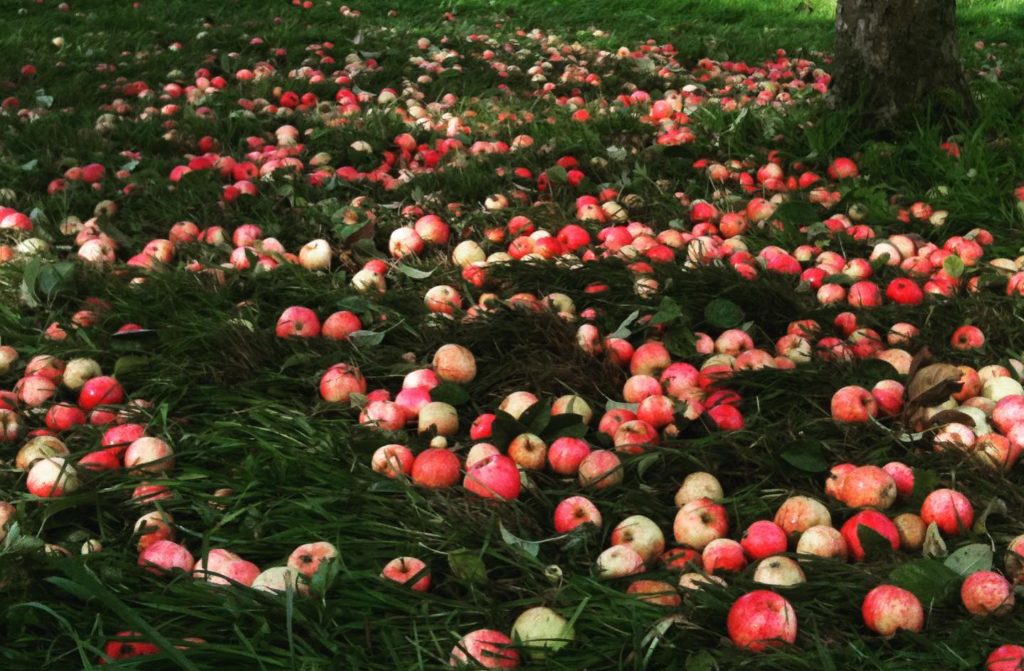
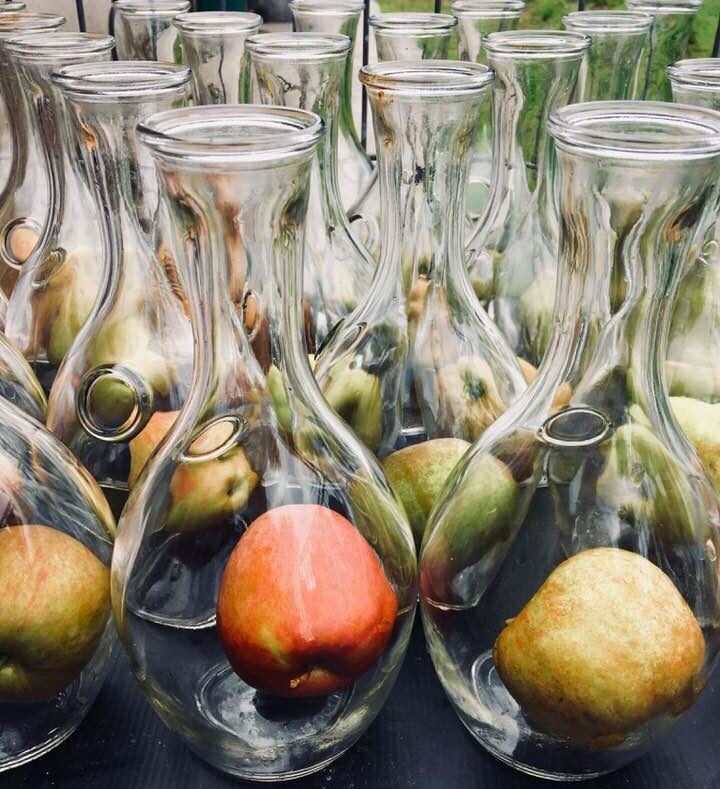 A genuine Norman brandy, Calvados is a famous elixir, nowadays from all over the world, where a new generation of curious and demanding consumers are getting seduced by its authentic taste. Indeed, a collective engagement of certain producers and merchant-breeders paid many efforts to convert its original narrow image and vintage consumption reputation, where it would eventually only have been consumed as a digestive and sometimes accompanied with a coffee (photo credits: Calvados Christian Drouin).
A genuine Norman brandy, Calvados is a famous elixir, nowadays from all over the world, where a new generation of curious and demanding consumers are getting seduced by its authentic taste. Indeed, a collective engagement of certain producers and merchant-breeders paid many efforts to convert its original narrow image and vintage consumption reputation, where it would eventually only have been consumed as a digestive and sometimes accompanied with a coffee (photo credits: Calvados Christian Drouin).
So why not becoming surprised by this versatile eau-de-vie which, unlike many other mouth alcohols, can vary and multiply the pleasures, without any risk of complex notes. Whether it is tasted pure, on ice, in a cocktail, in combination with a dish or as a simple ingredient constituting a recipe, Calvados would surely amaze you within its unequaled palette of flavors. Thus, through different players, we would introduce some alternatives, in order to validate your gastronomic passport and eventually wake up new inner appled senses, that you wouldn’t maybe have expected. By Alex Plato
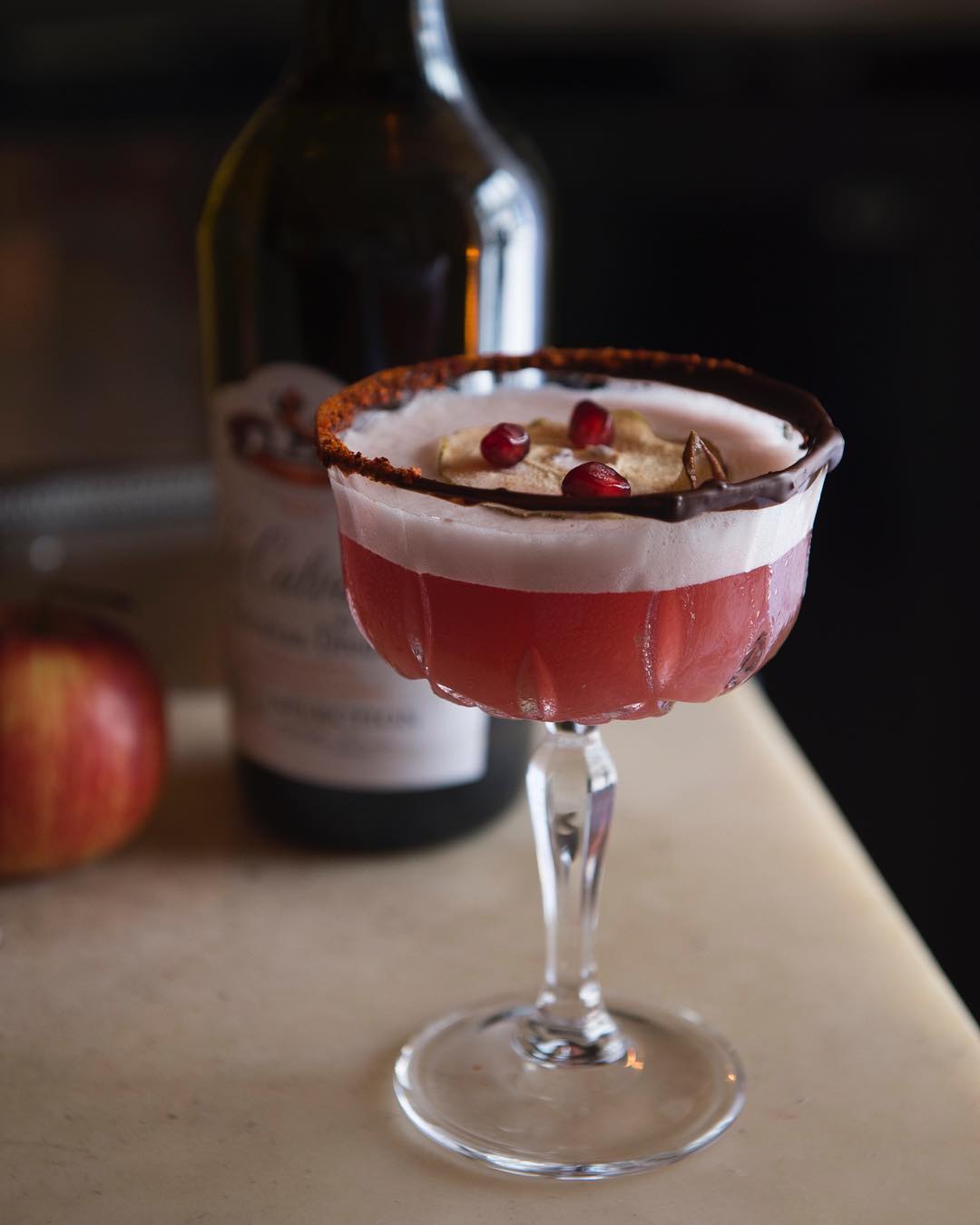 A living proof that tradition could be respected within innovation, this illustrious French eau-de-vie is originally made from the distillation of cider or perry (thus apple and pear based), obviously largely cultivated in Normandy. Respecting the ancestral and natural fermentation lasting at least 28 days, the fruits proportions remain at the discretion of the producer, as long as their free will to distillate their juice whether in a column still or aged in wood barrels, for a minimum period of two years. Mostly produced in specific well-defined areas of Calvados, Orne, Eure, Mayenne and Sarthe, where an absolute know-how has been developed to reach this precious Calvados appellation. This is where that this fruity spirit is minimally matured between 2 and 3 years, to finally titrate at least 40% alcohol volume (photo credit: Pierre Lucet-Penato).
A living proof that tradition could be respected within innovation, this illustrious French eau-de-vie is originally made from the distillation of cider or perry (thus apple and pear based), obviously largely cultivated in Normandy. Respecting the ancestral and natural fermentation lasting at least 28 days, the fruits proportions remain at the discretion of the producer, as long as their free will to distillate their juice whether in a column still or aged in wood barrels, for a minimum period of two years. Mostly produced in specific well-defined areas of Calvados, Orne, Eure, Mayenne and Sarthe, where an absolute know-how has been developed to reach this precious Calvados appellation. This is where that this fruity spirit is minimally matured between 2 and 3 years, to finally titrate at least 40% alcohol volume (photo credit: Pierre Lucet-Penato).
Furthermore, Calvados proposes three appellations: Pays d’Auge, Calvados and Domfrontais. For each of them, and beyond the varieties of apple and pear trees, the type of orchard and related soil, on which these trees grow, have a real impact on the final result. For instance, apple orchards generally consist of at least 20% local apple varieties, whose are about 70% bitter or sweet bitter varieties, and a maximum of 15% acidulous species. Among them, low-stem apple trees tall stalk orchards dominate the Normandy landscape, visibly characterized by green meadows where Norman cows, apple trees and even tall-stem apple trees can live together.
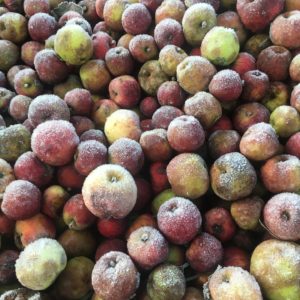 You have to know that apple trees give their first fruits after 10 years and reach their full maturity from 30 years old, and they can even reach the venerable age of 70. Furthermore, with 10 kg of apple, the average production results to around 6L of cider or even a Calvados bottle of 70 cl, at 40% vol. In order to reach this noble ratio, the maximum density for planting trees is 250 plants per hectare of apple ciders, and 150 plants per hectare for pear trees. Please note that during harvesting, mechanical shaking of pear trees is prohibited. Adding to this fact, you’ve to learn that pear trees were historically planted around orchards to protect apple trees, notably due to their deeper and strong tree root system, for example in winter!
You have to know that apple trees give their first fruits after 10 years and reach their full maturity from 30 years old, and they can even reach the venerable age of 70. Furthermore, with 10 kg of apple, the average production results to around 6L of cider or even a Calvados bottle of 70 cl, at 40% vol. In order to reach this noble ratio, the maximum density for planting trees is 250 plants per hectare of apple ciders, and 150 plants per hectare for pear trees. Please note that during harvesting, mechanical shaking of pear trees is prohibited. Adding to this fact, you’ve to learn that pear trees were historically planted around orchards to protect apple trees, notably due to their deeper and strong tree root system, for example in winter!
In the other hand, the low-stem orchards, more contemporary, are exclusively dedicated to lead an intensive fruit production, whereas the apple trees produce their first apples after 5 years, for a life expectancy of 30 years. The maintenance of the orchard is done mechanically and the density is much higher (1000 feet of apple trees per hectare), for an average yield of 35 tons per hectare. Very popular in the 80s, this mode of cultivation tends to fall into disuse, in favor of pre-orchards which yield much more interesting fruits.
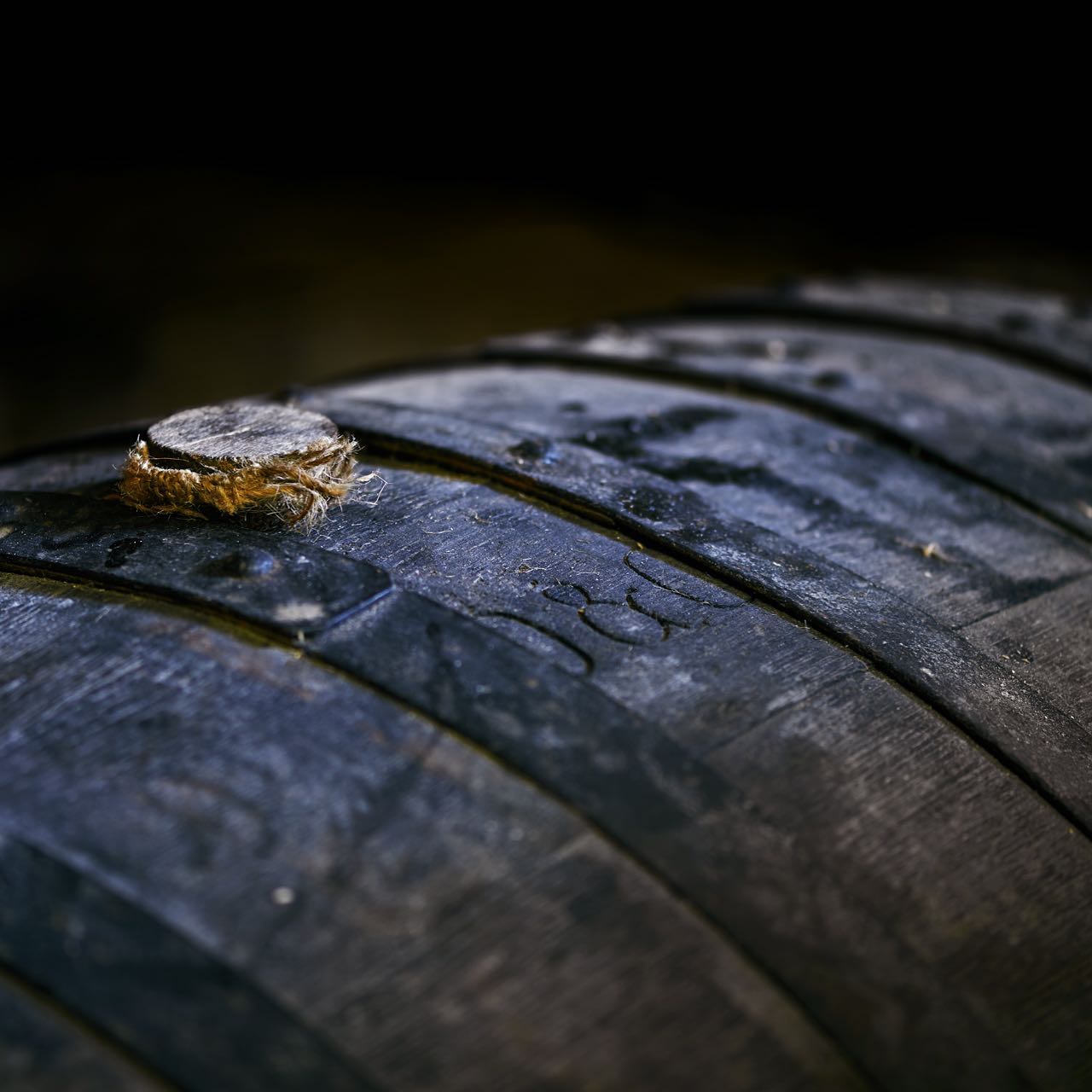 As a matter of fact, this Norman brandy may then be matured in a variety of oak barrels, reflecting the expression of different terroirs, spreading the rich aromatic diversity of this alcohol. Moreover, since a couple of years, a new alternative built on barrels of porto and madeira have been employed in order to launch new gustatory experiences. Among them, you could also count on the Blanche de Normandie, a real un-aged expression of this apple brandy (photo credits: Calvados Christian Drouin).
As a matter of fact, this Norman brandy may then be matured in a variety of oak barrels, reflecting the expression of different terroirs, spreading the rich aromatic diversity of this alcohol. Moreover, since a couple of years, a new alternative built on barrels of porto and madeira have been employed in order to launch new gustatory experiences. Among them, you could also count on the Blanche de Normandie, a real un-aged expression of this apple brandy (photo credits: Calvados Christian Drouin).
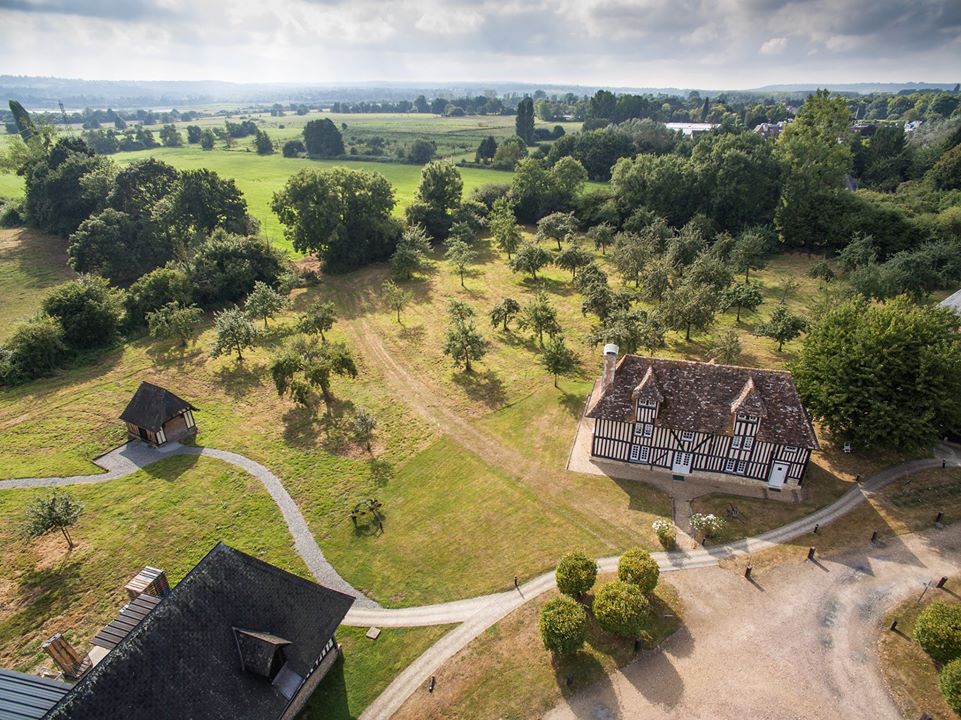 Regarding the appellations, the Calvados from the Pays d’Auge, is situated at the crossroads of the French departments of Calvados, Eure and Orne. This territory is particularly made up of shallow clay-limestone hillsides, above which a local production is especially composed with 70 to 100% of apples (the rest of pears). Adding to this, a natural fermentation lasts at least 42 days and continues with an old fashioned distillation, in an iron still, before a casual minimum aging period of two years.
Regarding the appellations, the Calvados from the Pays d’Auge, is situated at the crossroads of the French departments of Calvados, Eure and Orne. This territory is particularly made up of shallow clay-limestone hillsides, above which a local production is especially composed with 70 to 100% of apples (the rest of pears). Adding to this, a natural fermentation lasts at least 42 days and continues with an old fashioned distillation, in an iron still, before a casual minimum aging period of two years.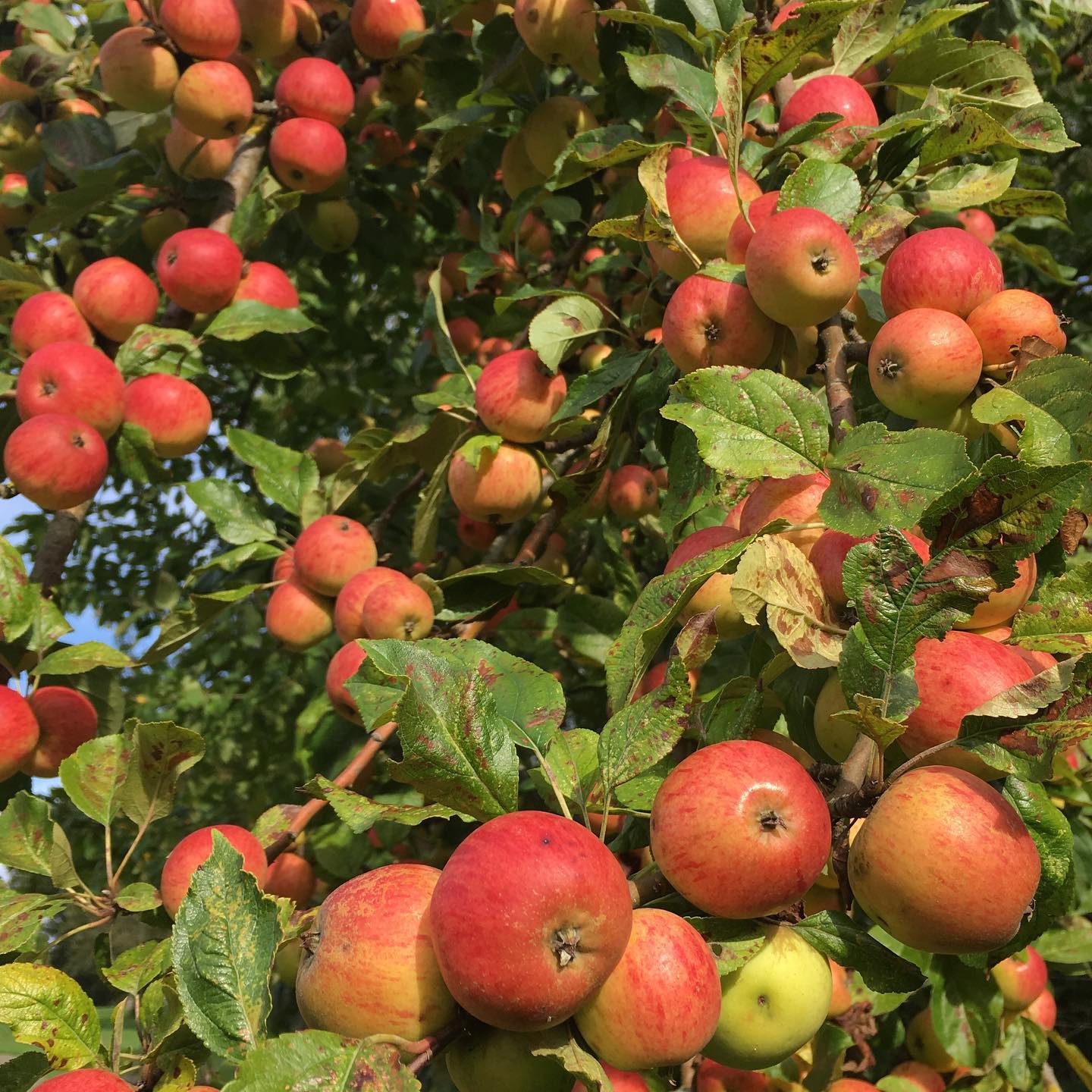 What about apples? Mostly harvested between late September until December, nearly 200 varieties of apples may be used in the Calvados production, unless only about twenty of them are more regularly cultivated. Among them, there are four main types of cider apples: bitter, bittersweet, sweet and tart. Bitter apples are rich in tannins and provide structure to the final product, whereas the bittersweet ones bring fruity and richness and the sweet apples are mainly used for their contribution to the alcohol content of cider. Last but not least, the tartness stock provides the right amount of acidity. Once harvested, the fruits are stored in granaries, grouped into paloxes (large boxes of around 300 kg), or even on the ground for the ripening phase.
What about apples? Mostly harvested between late September until December, nearly 200 varieties of apples may be used in the Calvados production, unless only about twenty of them are more regularly cultivated. Among them, there are four main types of cider apples: bitter, bittersweet, sweet and tart. Bitter apples are rich in tannins and provide structure to the final product, whereas the bittersweet ones bring fruity and richness and the sweet apples are mainly used for their contribution to the alcohol content of cider. Last but not least, the tartness stock provides the right amount of acidity. Once harvested, the fruits are stored in granaries, grouped into paloxes (large boxes of around 300 kg), or even on the ground for the ripening phase.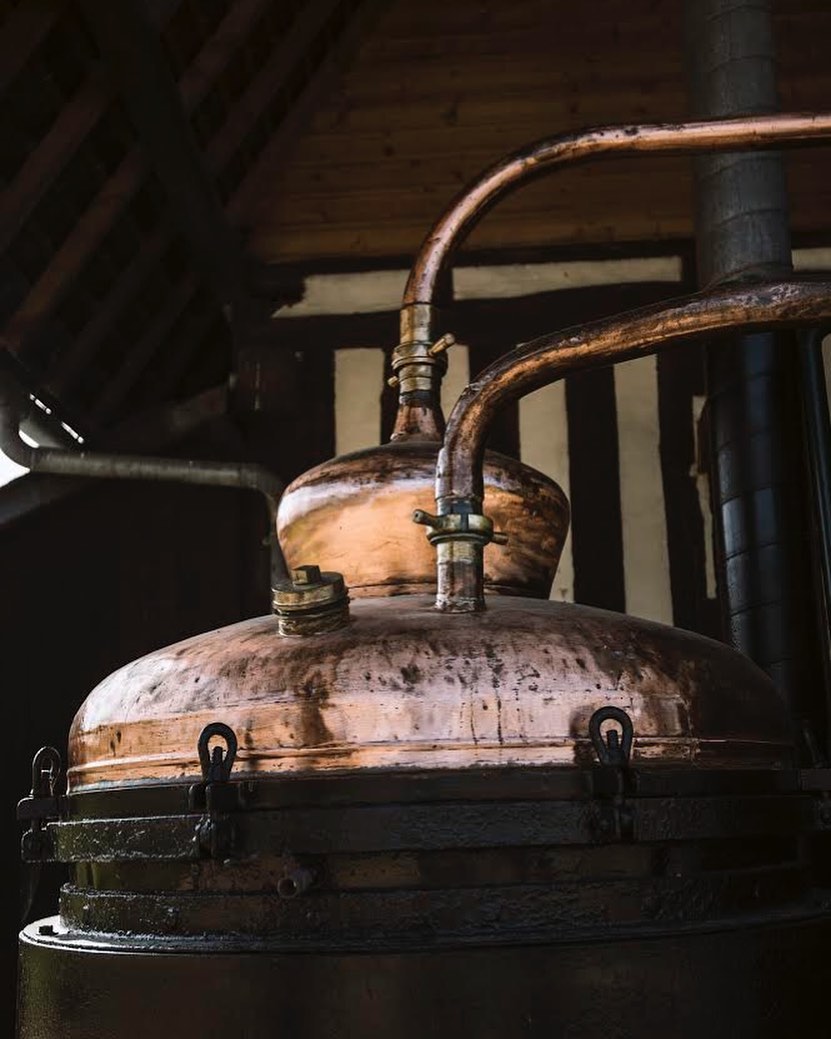 At first sight, the most common ironing still, symbolized by the illustrious ironing alembic, composed of copper to boil the cider, a heating part and finally a refrigerating copper coil to liquefy the remaining alcohol vapors. Used for the two distillations, this device is mandatory for the distillation processed in the previously cited Calvados Pays d’Auge appellation. For example, pictured here, the mobile still, property of Calvados Christian Drouin, settled in 1946 but now retired.
At first sight, the most common ironing still, symbolized by the illustrious ironing alembic, composed of copper to boil the cider, a heating part and finally a refrigerating copper coil to liquefy the remaining alcohol vapors. Used for the two distillations, this device is mandatory for the distillation processed in the previously cited Calvados Pays d’Auge appellation. For example, pictured here, the mobile still, property of Calvados Christian Drouin, settled in 1946 but now retired.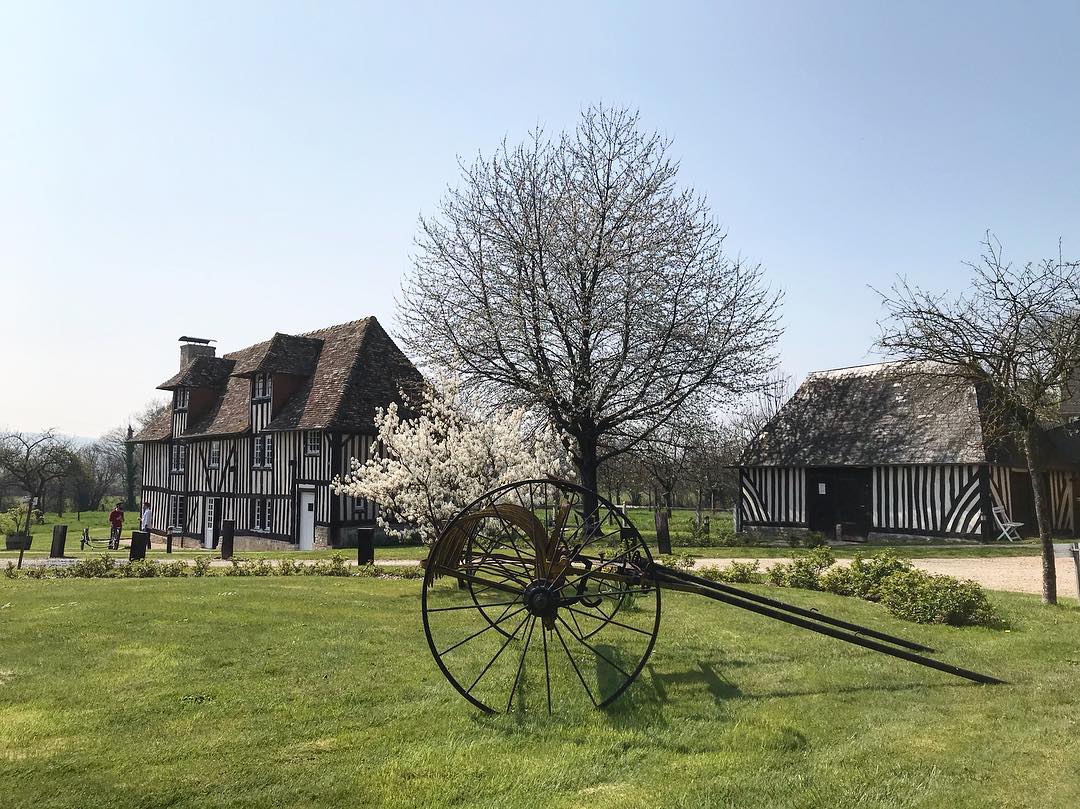 Following our first discovery of their Gin in our previous focused article, let’s get into the Calvados‘ core of the Domaine Drouin. Their Coeur de Lion estate is also located in the heart of the Pays d’Auge, in an ancient Norman farmhouse adorned with a typical 17th century Augeronne architecture (photo credits: Calvados Christian Drouin).
Following our first discovery of their Gin in our previous focused article, let’s get into the Calvados‘ core of the Domaine Drouin. Their Coeur de Lion estate is also located in the heart of the Pays d’Auge, in an ancient Norman farmhouse adorned with a typical 17th century Augeronne architecture (photo credits: Calvados Christian Drouin).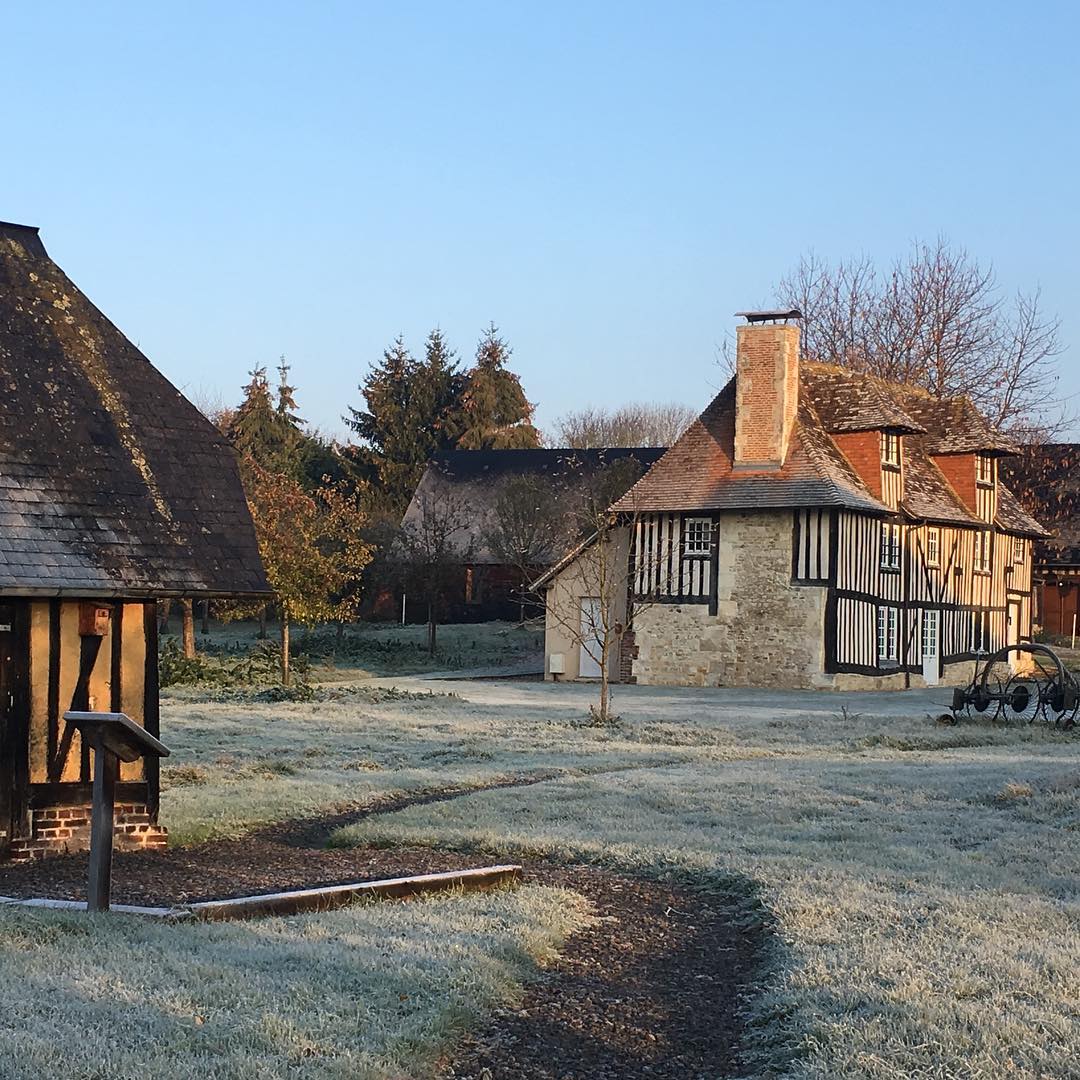 Family unity making strength, you would be amazed to learn their homemade production processes. Since their large estate is equipped by traditional Norman devices, such as a press, a distillation workshop, aging cellars, a packaging workshop and of course orchards, planted between 1991 and 1993. This surface is only composed of high-stem apple trees, whose fruits are duly selected in order to obtain a balanced sweet and acidity content, within a wedding between different varieties of apples (a proper alloy among sweet, bittersweet, bitter and tangy apples). This oriented diversity is prominent in the development of a genuine and worthy Calvados.
Family unity making strength, you would be amazed to learn their homemade production processes. Since their large estate is equipped by traditional Norman devices, such as a press, a distillation workshop, aging cellars, a packaging workshop and of course orchards, planted between 1991 and 1993. This surface is only composed of high-stem apple trees, whose fruits are duly selected in order to obtain a balanced sweet and acidity content, within a wedding between different varieties of apples (a proper alloy among sweet, bittersweet, bitter and tangy apples). This oriented diversity is prominent in the development of a genuine and worthy Calvados. 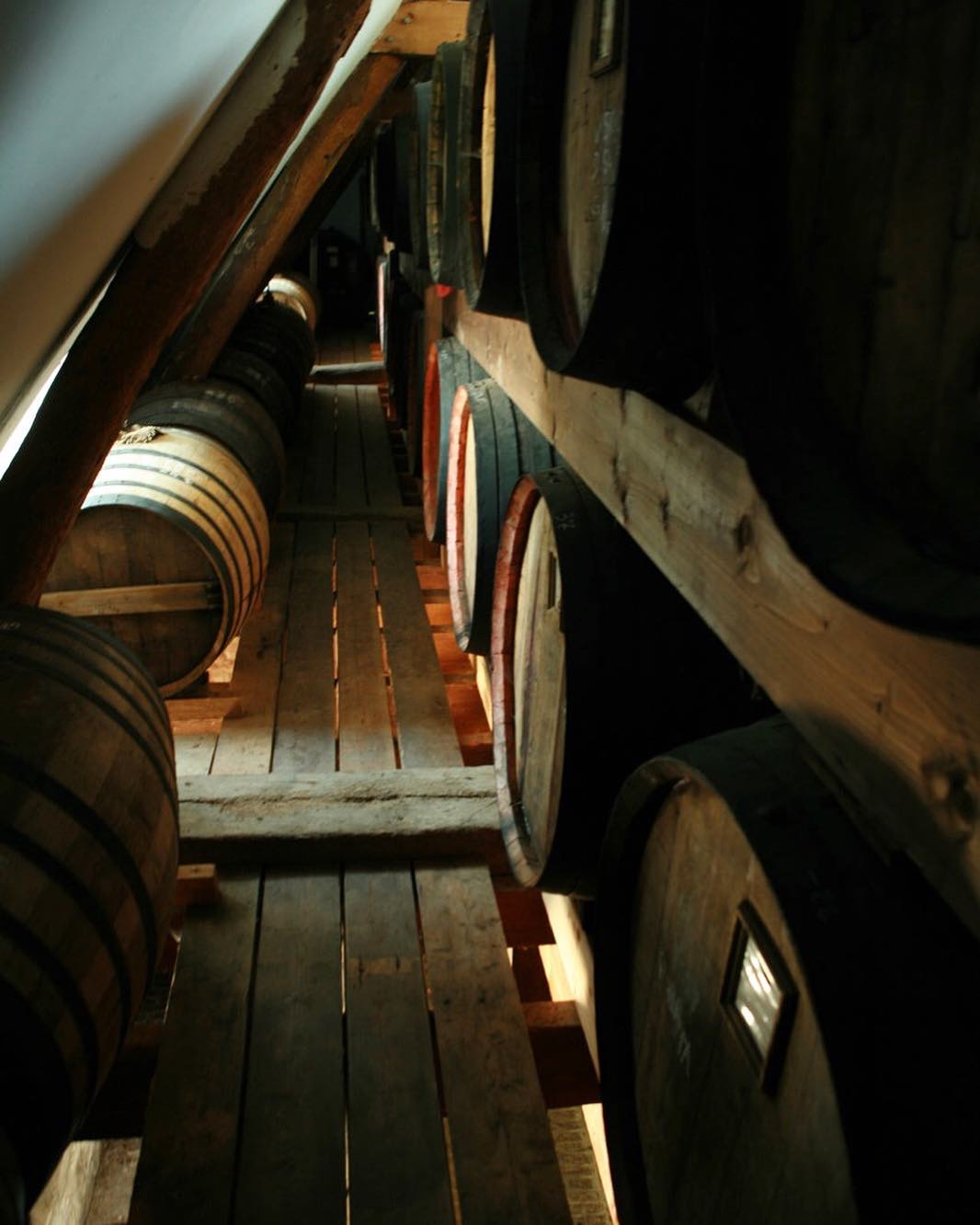 Then came the aging session, the Calvados Drouin is aged in cellars, essentially containing small barrels of 250 liters (where the aging may be accelerated) and a few others of nearly 600 liters.
Then came the aging session, the Calvados Drouin is aged in cellars, essentially containing small barrels of 250 liters (where the aging may be accelerated) and a few others of nearly 600 liters. 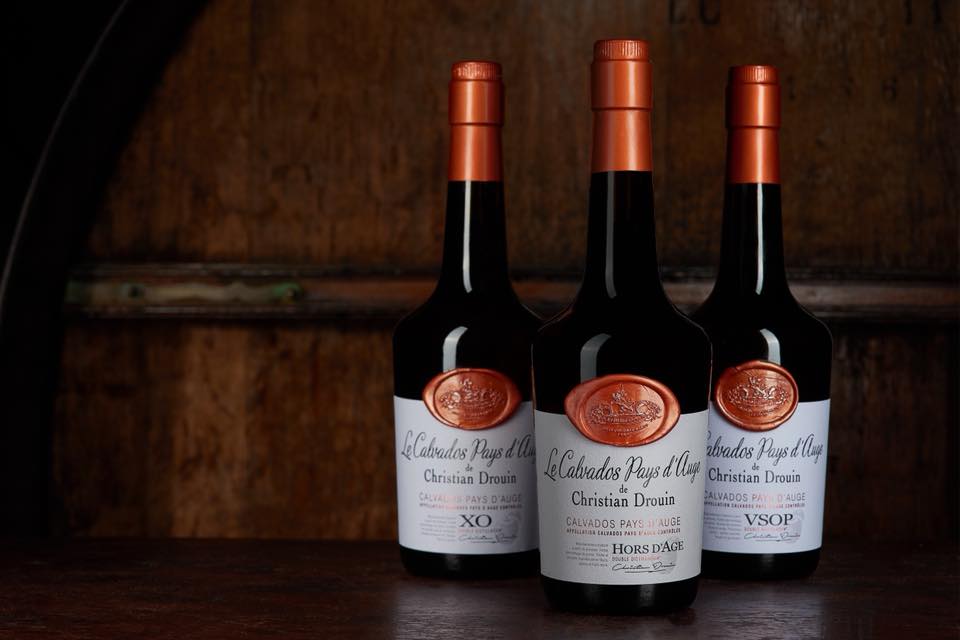 Among the long list of their available cuvées, that we invite you to taste, why don’t you initiate your journey with a VSOP? As we have seen before, made from a double distillation and benefiting from a wide choice of flavored barrels, this premium blend offers an incomparable palette and aromatic richness, this 100% apple Calvados is aged at least 5 years in recent barrels, then 4 to 5 years in barrels aged 15 years.
Among the long list of their available cuvées, that we invite you to taste, why don’t you initiate your journey with a VSOP? As we have seen before, made from a double distillation and benefiting from a wide choice of flavored barrels, this premium blend offers an incomparable palette and aromatic richness, this 100% apple Calvados is aged at least 5 years in recent barrels, then 4 to 5 years in barrels aged 15 years. 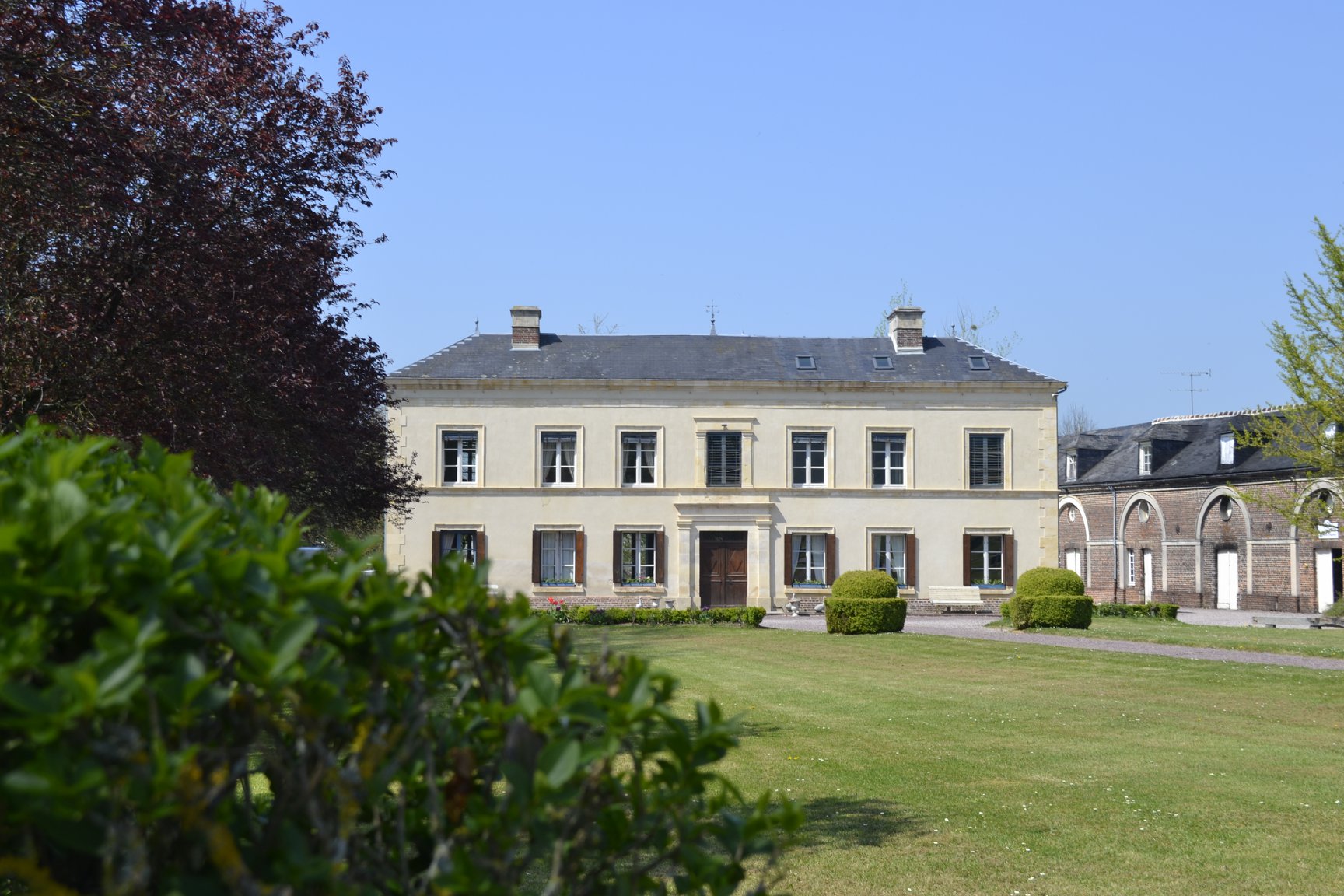 This time we dive into the fairy universe of one of the Pays d’Auge appellation’s flagships! Located on the Cider Route, in the charming village of Victot-Pontfol, the Domaine Dupont holds multiple Norman facets, from the production of ciders, along the pommeau and of course Calvados (photo credits: Domaine Dupont).
This time we dive into the fairy universe of one of the Pays d’Auge appellation’s flagships! Located on the Cider Route, in the charming village of Victot-Pontfol, the Domaine Dupont holds multiple Norman facets, from the production of ciders, along the pommeau and of course Calvados (photo credits: Domaine Dupont).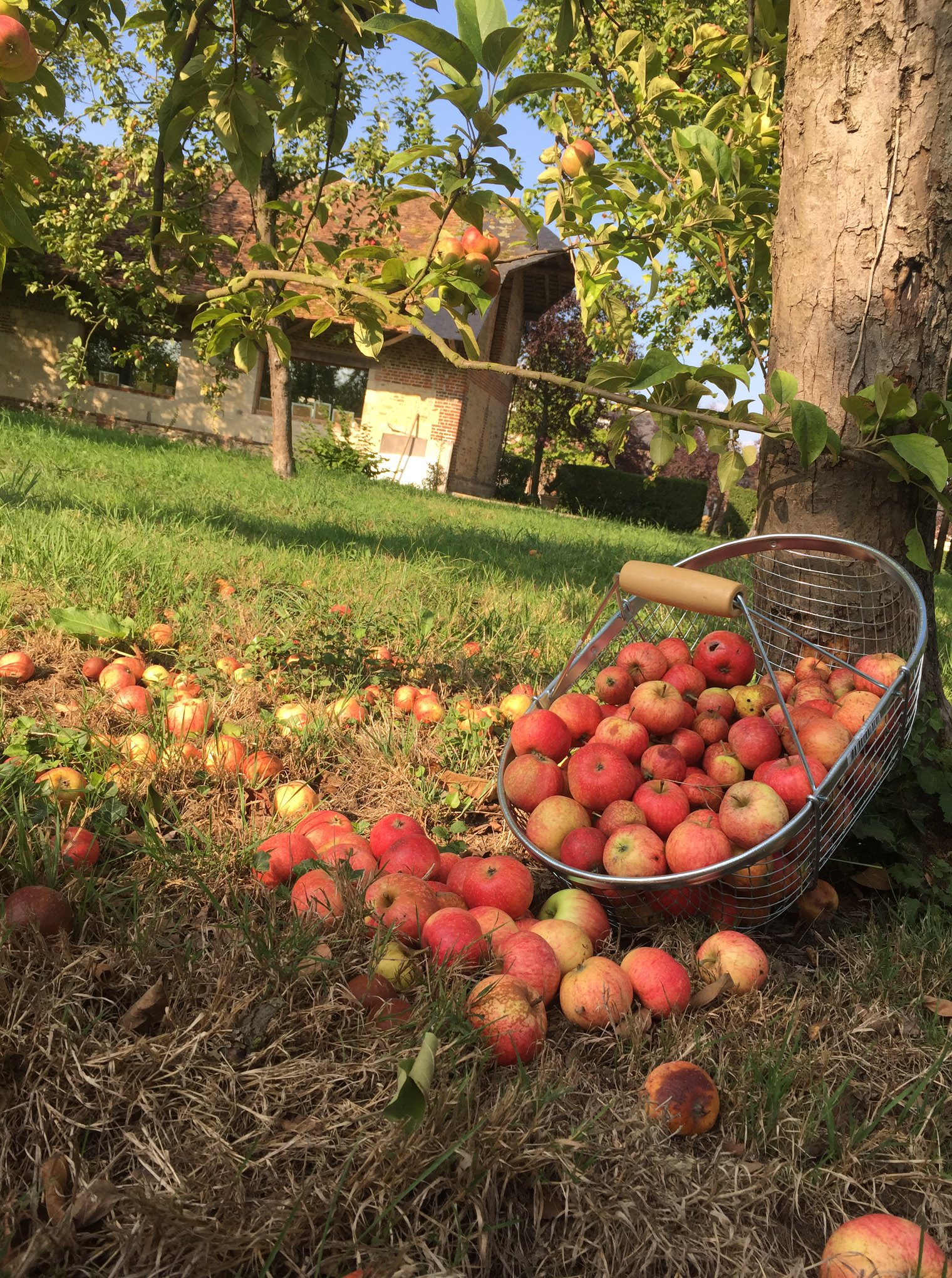 Initiated in 1887 but accelerated one century later, on the impulse of Étienne Dupont, the Calvados Dupont enhances the real spirit of Normandy and for sure, the Pays d’Auge due to a flexible double distillation, occurring six months after the cider fermentation process, an obliged passage to obtain the AOC Pays d’Auge label.
Initiated in 1887 but accelerated one century later, on the impulse of Étienne Dupont, the Calvados Dupont enhances the real spirit of Normandy and for sure, the Pays d’Auge due to a flexible double distillation, occurring six months after the cider fermentation process, an obliged passage to obtain the AOC Pays d’Auge label. 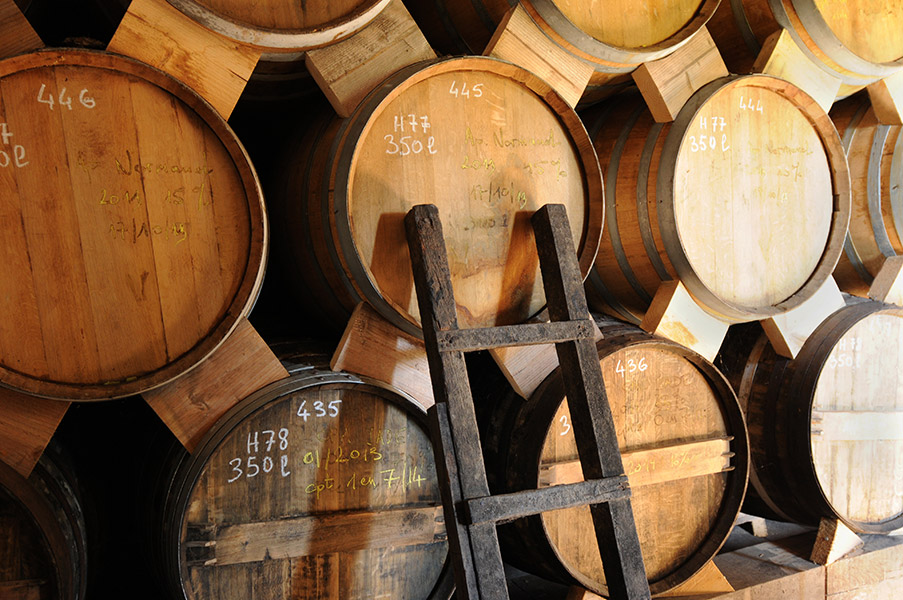 That’s why we invite you to feel the expression of this history of a certain terroir, through fruits and spirits, within a tasting dilemma between young fruity and dashing Calvados, while the older ones got softened, more intense and in the same way, more harmonious, due in particular to a large palette of aromas, gradually enriched through aging, in oak barrels. This result is reflected by a dress which displays visible amber reflections over time.
That’s why we invite you to feel the expression of this history of a certain terroir, through fruits and spirits, within a tasting dilemma between young fruity and dashing Calvados, while the older ones got softened, more intense and in the same way, more harmonious, due in particular to a large palette of aromas, gradually enriched through aging, in oak barrels. This result is reflected by a dress which displays visible amber reflections over time.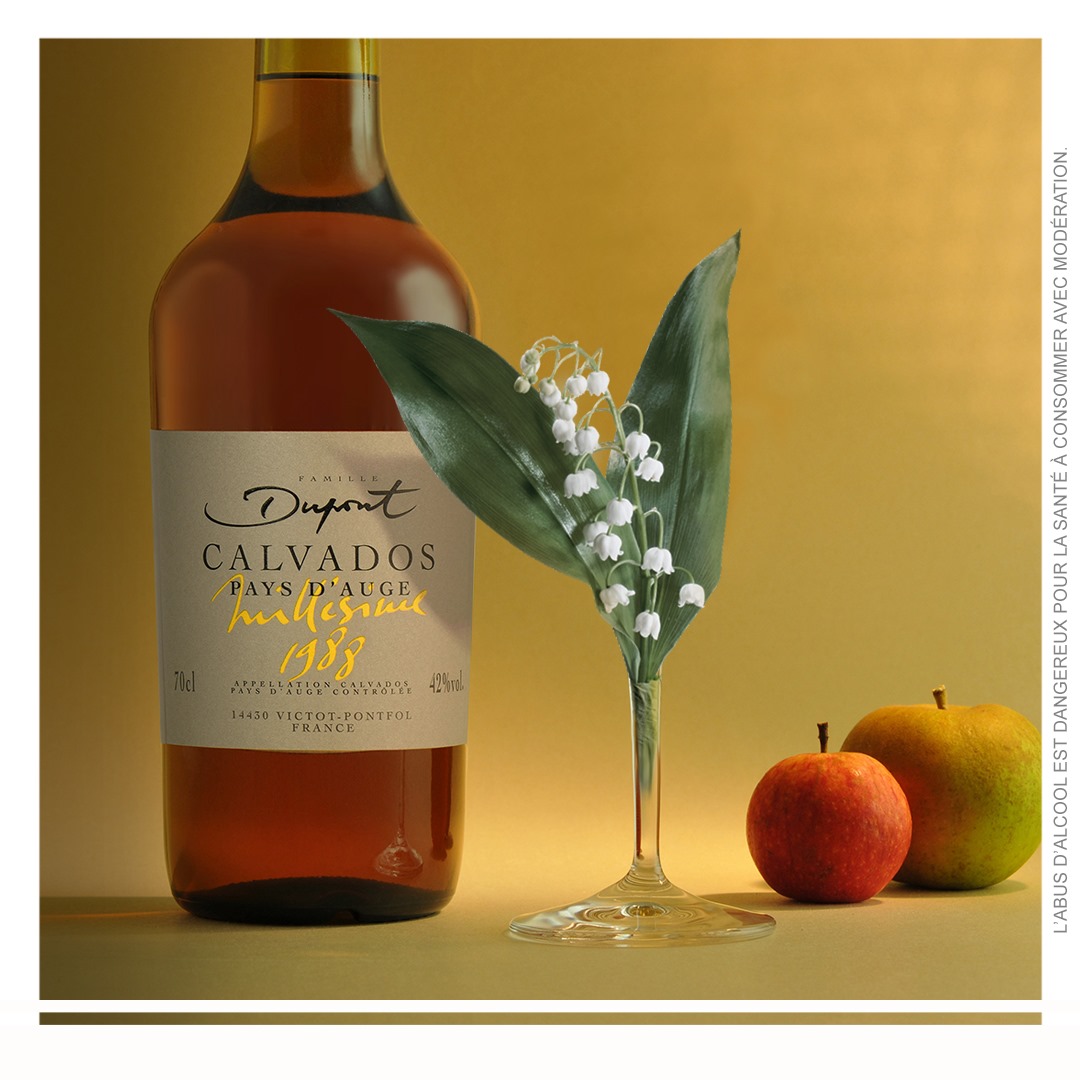 Otherwise, you have a consequent choice to discover their different worthy vintages, such as this brilliant Millesime 1972. Naturally distilled this eponym year and aged in barrels and toasted oak barrels of 400 liters. It has been raised on the native representative soils, mostly composed of clay and Oxfordian marnes, to extract the best of bittersweet apples with a moderate complement of acidulated apples.
Otherwise, you have a consequent choice to discover their different worthy vintages, such as this brilliant Millesime 1972. Naturally distilled this eponym year and aged in barrels and toasted oak barrels of 400 liters. It has been raised on the native representative soils, mostly composed of clay and Oxfordian marnes, to extract the best of bittersweet apples with a moderate complement of acidulated apples. This premium bottled on order Calvados proposes a very dark mahogany robe, unless reflecting a bright and limpid appearance, more typical of this apple lineage. Therefore, feel free to appreciate its smooth fragrance, mainly offering wooden and spicy aromas, before a notable fruity finish, even from empty glasses… This sensation goes once in your palate, thanks to very intense candied notes, still enriched with these woody and spicy tones, in a way a real balance between bitterness and freshness, supported by the remaining touch of tobacco flavor.
This Calvados is eager to be stored for a long time, your bottle uprightly stood. We recommend you to appreciate it as a digestif, at ambient temperature, accompanied with a cigar or not…
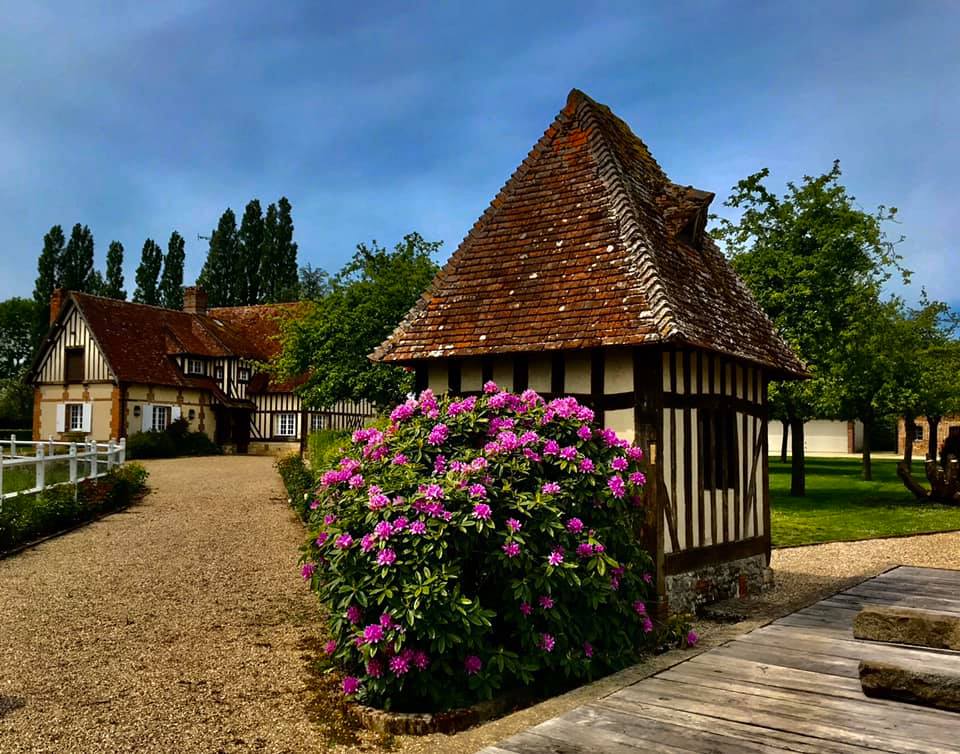 A few steps thrown away from there, the history of the Groult family distillery started in the 19th century at the Clos de la Hurvanière. This farm, located on the heights of the Pays d’Auge, precisely in Saint-Cyr du Roqueray, is spread on 27 hectares, mostly composed of fine orchards, hosting no less than 6000 apple trees (15 hectares made of tall-stem apple trees and 12 hectares of low-stem ones).
A few steps thrown away from there, the history of the Groult family distillery started in the 19th century at the Clos de la Hurvanière. This farm, located on the heights of the Pays d’Auge, precisely in Saint-Cyr du Roqueray, is spread on 27 hectares, mostly composed of fine orchards, hosting no less than 6000 apple trees (15 hectares made of tall-stem apple trees and 12 hectares of low-stem ones). Among the 30 varieties of cider apples used, you may more frequently find Antoinette, Fréquin Rouge, Bisquet, Moulin à Vent (Windmill)… In fact, bitter and bittersweet apples represent nearly 70% of the production, where sweet apples, like Bedan and Noël des Champs take part of 20% from this ratio. Last but not least, tangy apples symbolized by Rambaud and Petit Jaune complete the last 10% of this wide manually harvested and sorted family.
Among the 30 varieties of cider apples used, you may more frequently find Antoinette, Fréquin Rouge, Bisquet, Moulin à Vent (Windmill)… In fact, bitter and bittersweet apples represent nearly 70% of the production, where sweet apples, like Bedan and Noël des Champs take part of 20% from this ratio. Last but not least, tangy apples symbolized by Rambaud and Petit Jaune complete the last 10% of this wide manually harvested and sorted family. 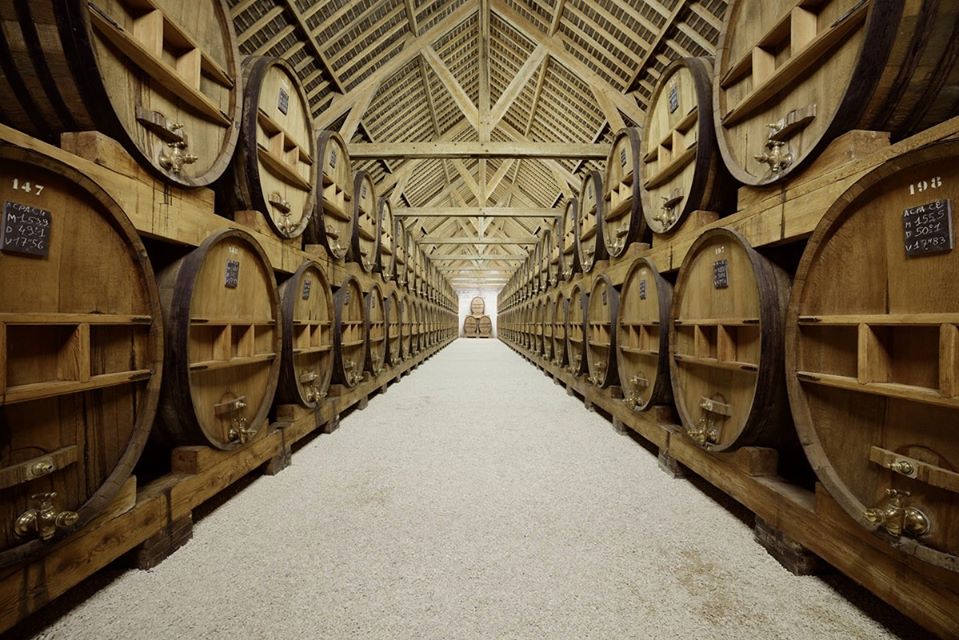 In 1952, this distillery was completed within a large aging cellar, in which oak casks of more than 12,000 liters were installed. This new momentum allowed the team to expand their production, as well due to the late arrival of recent orchards. This was also made possible by the extension of their Calvados warehouse, while building the two largest cellars of the region.
In 1952, this distillery was completed within a large aging cellar, in which oak casks of more than 12,000 liters were installed. This new momentum allowed the team to expand their production, as well due to the late arrival of recent orchards. This was also made possible by the extension of their Calvados warehouse, while building the two largest cellars of the region.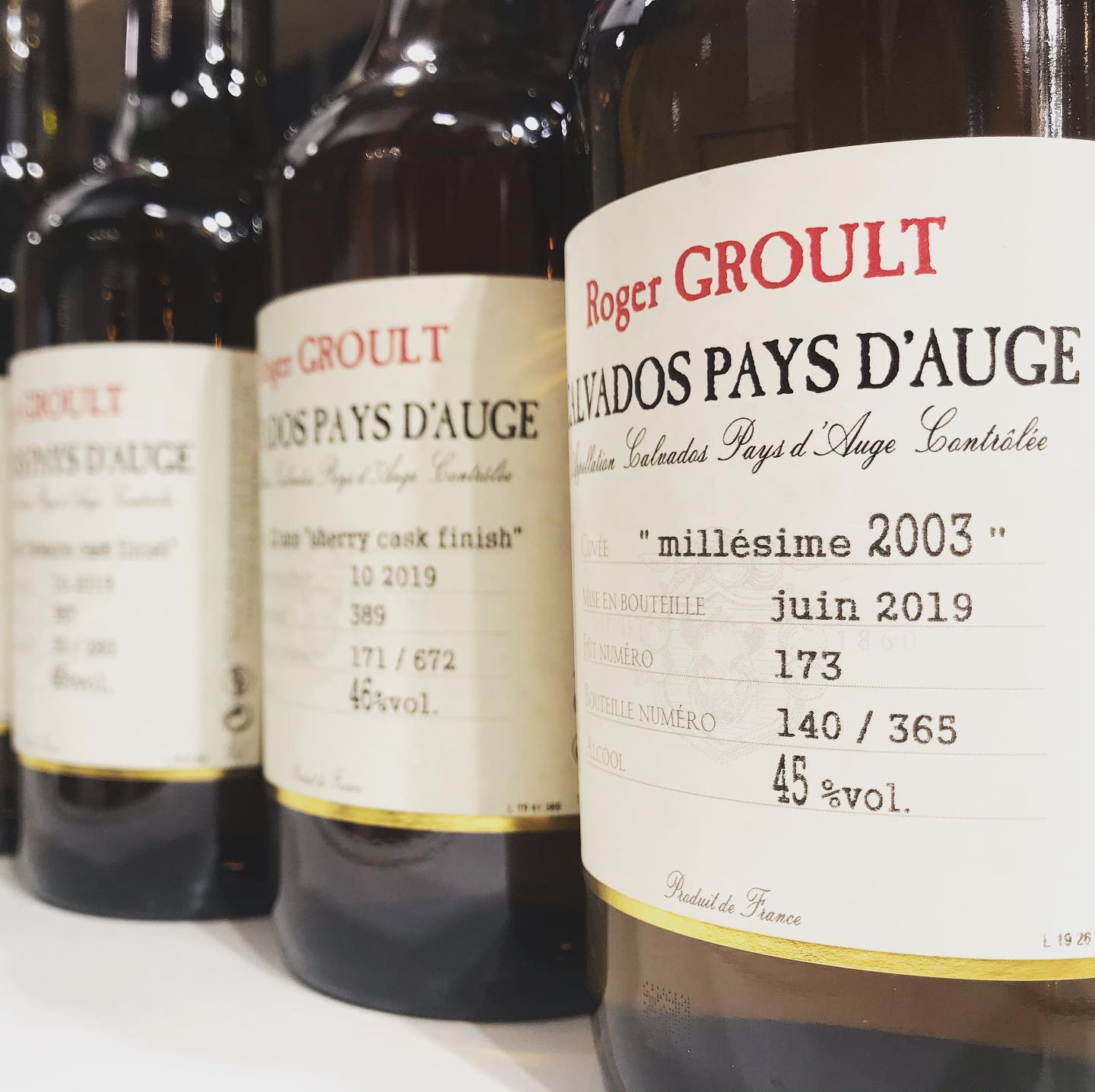 Cherry on the cake, a double distillation in old small stills, fed by wood, is operated after the natural fermentation of their ciders, for a period of 6 months on fine lees. A good occasion to get ready for the final plunge!
Cherry on the cake, a double distillation in old small stills, fed by wood, is operated after the natural fermentation of their ciders, for a period of 6 months on fine lees. A good occasion to get ready for the final plunge! It’s also our mission to introduce you the other AOC Calvados approach! Nowadays lead by its third generation of Calvados enthusiasts, the Calvados Coquerel shares its best nectars elaborated in their distillery, located a few kilometers from the Mont-Saint-Michel. Among this happy tribe who succeeded to make this family affair as the first regional independent productor (with 650K bottles/year), Pierre-Marin Neuhaus tends to pursue the closest as possible this family spirit, initiated since 1937. As staunch defenders of this certain Norman tradition since decades, their spirits have been selected and assembled for their unique assets, such as their aromatic profiles representing the best of this so much appled French region of Normandy, also protected under the Appellation Calvados Contrôlée (AOC) label, guaranteeing a premium Calvados quality (photo credits: Calvados Coquerel).
It’s also our mission to introduce you the other AOC Calvados approach! Nowadays lead by its third generation of Calvados enthusiasts, the Calvados Coquerel shares its best nectars elaborated in their distillery, located a few kilometers from the Mont-Saint-Michel. Among this happy tribe who succeeded to make this family affair as the first regional independent productor (with 650K bottles/year), Pierre-Marin Neuhaus tends to pursue the closest as possible this family spirit, initiated since 1937. As staunch defenders of this certain Norman tradition since decades, their spirits have been selected and assembled for their unique assets, such as their aromatic profiles representing the best of this so much appled French region of Normandy, also protected under the Appellation Calvados Contrôlée (AOC) label, guaranteeing a premium Calvados quality (photo credits: Calvados Coquerel).
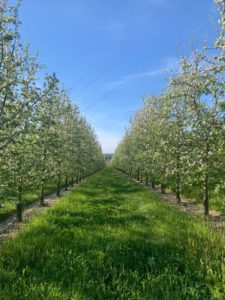 For your information, on their authentic orchards, also implemented by their 200 surrounding farmers, we are proud to announce that the polyculture is king, thanks to a happy cohabitation between cows, sheep and for sure apples. Plus, in these fields, an eco-friendly manner helps to maintain these rich soils, notably through an organic fertilization, completed by a natural lightening, while letting drop the first apples on the ground (most of the time, the crooked elements).
For your information, on their authentic orchards, also implemented by their 200 surrounding farmers, we are proud to announce that the polyculture is king, thanks to a happy cohabitation between cows, sheep and for sure apples. Plus, in these fields, an eco-friendly manner helps to maintain these rich soils, notably through an organic fertilization, completed by a natural lightening, while letting drop the first apples on the ground (most of the time, the crooked elements).
Thus, this poor pollution effect results to a visible high biodiversity, offering a pure living space to insects, flowers and other kinds of species. In an other hand, this policy permits the safety of the fragile water tables, of these Norman orchards. A real sustainable lifestyle example to inspire other lands and specialities, in a way!
In order to reach the Calvados Coquerel standards, the exploitation counts four families of apples. Among them, you may find the sweet ones, baptized Germaine, Rouge Dure, mostly acclaimed for their natural and perfumed sugar. Furthermore, there are also the bitter varieties, aka the Domaine and Fréquin, bringing balance and harmony, eventually to connect with the Bedan, Rouge, Bisquet and Binet families, which are sweet-bitter apples, offering a durable tannin touch. Last but not least, the tart ones, standing out through the illustrious Rambault and René Martin, especially for their freshness and the subtle taste they could fulfill your senses.
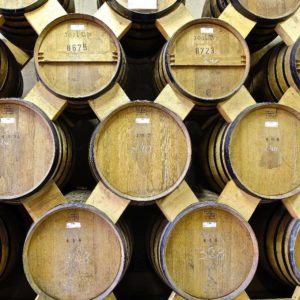 Furthermore, once these apples and a slight complement of pears are harvested and pressed, the juice obtained from those multiple fruits is left in a natural fermentation for a minimum duration of 28 days to become cider, whose aromas are then concentrated and exalted during the next step, within the distillation on lees. Soon metamorphosed into a crystalline brandy, where this final fruity wedding operated in the three traditional home copper column-stills, before the last maturation in many of the 2,500 unmissable oak barrels and 70 foudres!
Furthermore, once these apples and a slight complement of pears are harvested and pressed, the juice obtained from those multiple fruits is left in a natural fermentation for a minimum duration of 28 days to become cider, whose aromas are then concentrated and exalted during the next step, within the distillation on lees. Soon metamorphosed into a crystalline brandy, where this final fruity wedding operated in the three traditional home copper column-stills, before the last maturation in many of the 2,500 unmissable oak barrels and 70 foudres!
Now that we’re informed about the process, who’s not excited to discover the Calvados Coquerel selection? Indeed, following to this statement, we would be glad to introduce you the main products elaborated by this centenary Norman house, and accompanied with a couple of suggested original cocktails, suitable to the personality of each element, to prepare at your place, at your own liking and convenience for sure! An alternative privilege to appreciate a multi-awarded Calvados, thanks to more than a hundred medals, including five times the Grand Prize of Honor from the French President, recompensing the most beautiful cellars in Calvados.


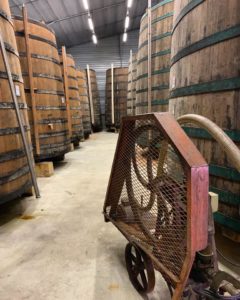 The emblematic Coquerel Fine edition is naturally one of their signature blends, aged at least 2 years in French oak barrels. With this Calvados, enriched with fresh cider fragrance, you would quickly perceive the fruity and fresh personality of apples, associated with the sweet vanilla notes, before a floral final touch. This fantastic wedding results from a fine aging in young fine-grained oak barrels, during the first months of aging. Such an incomparable sensation that even the cellar master affirms that tasting the Coquerel Fine “gives me the impression of crunching in the apple“.
The emblematic Coquerel Fine edition is naturally one of their signature blends, aged at least 2 years in French oak barrels. With this Calvados, enriched with fresh cider fragrance, you would quickly perceive the fruity and fresh personality of apples, associated with the sweet vanilla notes, before a floral final touch. This fantastic wedding results from a fine aging in young fine-grained oak barrels, during the first months of aging. Such an incomparable sensation that even the cellar master affirms that tasting the Coquerel Fine “gives me the impression of crunching in the apple“.
To enjoy it, the team recommends you to use 5 cl of this nectar into the so called Coquerel Tonic, completed with 15 cl of tonic water and 2 apple slices in a highball glass, efficiently stirred and filled with ice.
 The Coquerel family affirms that any Calvados is above all, a great cider. That’s maybe one of the reasons why this Coquerel VSOP was imagined by the grandfather, who somehow wished to create a certain balanced harmony between the freshness of apples and the sweet spicy notes brought by a minimum ageing of 4 years in small oak barrels.
The Coquerel family affirms that any Calvados is above all, a great cider. That’s maybe one of the reasons why this Coquerel VSOP was imagined by the grandfather, who somehow wished to create a certain balanced harmony between the freshness of apples and the sweet spicy notes brought by a minimum ageing of 4 years in small oak barrels.
Therefore, this slightly amber juice holds mahogany reflects, and spreads a generous aromatic peppery perfume, full of cooked apples, but also woody and vanilla scents. Once in mouth, you would be amazed by its soft and fruity sweetness, really matching with the reminiscent spices in a full-bodied profusion, opening on candied fruit and gingerbread notes, altogether evolving towards a delicious final touch, enriched with dried fruit. In fact, a worthy Calvados undoubtedly better to consume pure, on ice, or as a long drink with some tonic or as a base for premium cocktails.
For instance, we invite you to employ 6 cl of this Coquerel Calvados VSOP into a Normand Mule cocktail, an alternative version of the classic Moscow Mule, preferably to implement in a copper mug, with 12 cl of fresh ginger beer, 1 cl of squeezed lime, after dropping the skin at the bottom of the glass. Don’t hesitate to decorate your creation with apple and lime slices!
“Coquerel VSOP is the perfect balance to find back the fruity aspects of our Fine and the smoothness of our XO” according to the cellar master.
 Then, we switch to the Coquerel XO Hors d’Âge is one of the emblematic blends of the distillery, thanks to its powerful and complex tasteful approach. Thus, this subtly golden Calvados has turned into sparkling amber reflections, due to its maturation from 6 to 10 years in old barrels. This period conferred to this elixir an optimal maturity and eventually a rich aromatic balance between elegant notes of baked apples, brioche and hazelnut, evolving on aromas of lemon, dark chocolate and caramel, in your palate. A real round juice, provided with a very long Tatin pastry final feeling, to consume pure.
Then, we switch to the Coquerel XO Hors d’Âge is one of the emblematic blends of the distillery, thanks to its powerful and complex tasteful approach. Thus, this subtly golden Calvados has turned into sparkling amber reflections, due to its maturation from 6 to 10 years in old barrels. This period conferred to this elixir an optimal maturity and eventually a rich aromatic balance between elegant notes of baked apples, brioche and hazelnut, evolving on aromas of lemon, dark chocolate and caramel, in your palate. A real round juice, provided with a very long Tatin pastry final feeling, to consume pure.
Here, the Coquerel‘s suggestion would be the Old Fashioned, Really? cocktail, to build with 4 cl of Coquerel Calvados XO and one sugar cube, naturally in an old fashioned glass. Then, wet the solution in one dash of bitter Angostura, before a splash of club soda and an orange twist, for your courtoisie. You may also add a large ice cube in case of heatwave!
“Coquerel XO is made from a blend of spirits aged at least 6 years selected by me, so that they are perfectly balanced between visual elegance and aromatic richness” still admits the cellar master.
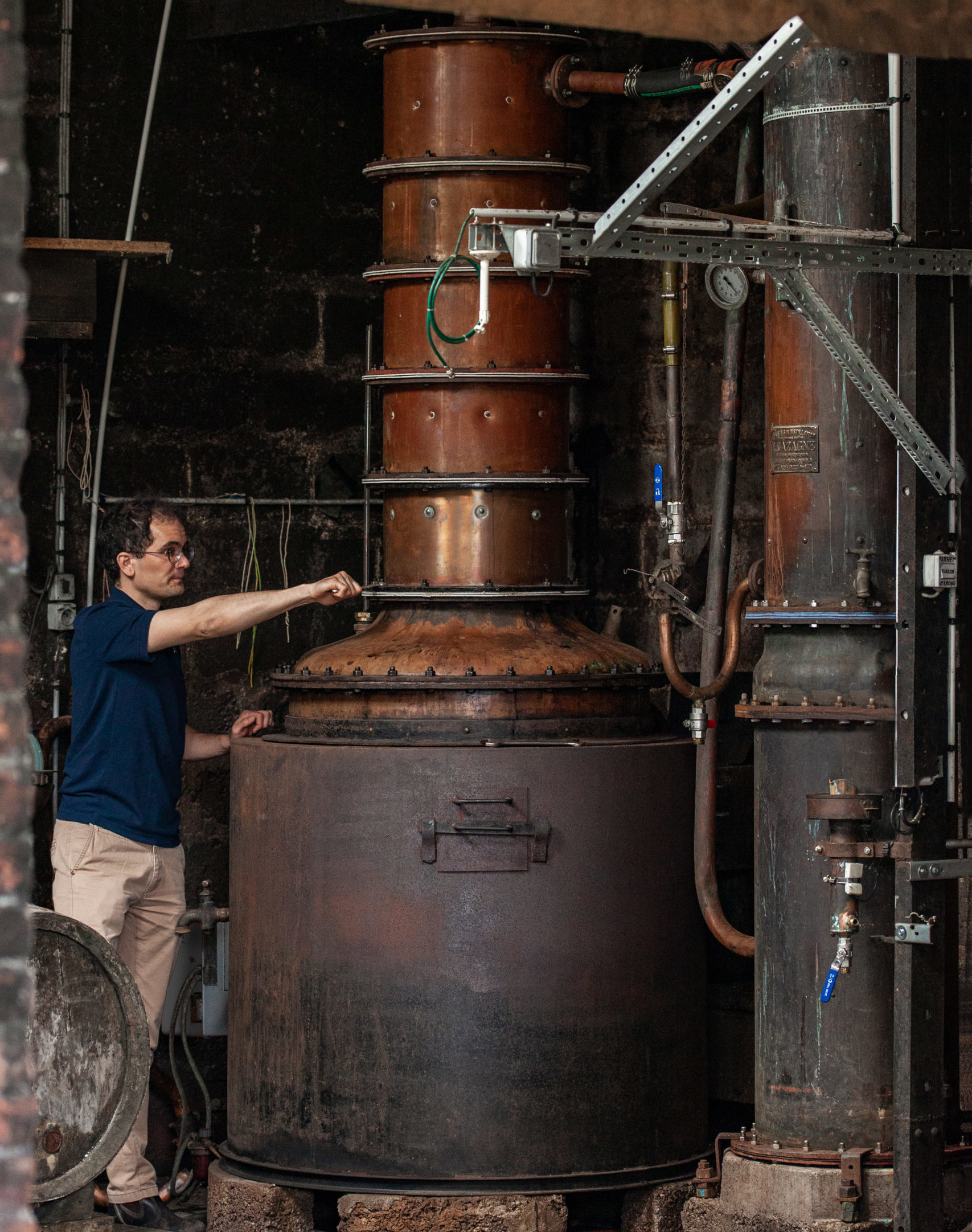 Also an authentic AOC Calvados, a neighbored distillery, formerly easily identifiable by the parchment-like labels featuring on their bottles, the Maison Garnier was founded in 1877 and operated a brand new blue packaging lately. Once upon a time, a wine and spirits merchant decided to conduct its own Calvados production activity. Located in the Orne department, near Condé sur Noireau, the Maison Garnier is run by the dynamic Nicolas Garnier, a cellar master who eventually traveled the world, before carrying the golden family torch within this Norman adventure (photo credits: Calvados Garnier).
Also an authentic AOC Calvados, a neighbored distillery, formerly easily identifiable by the parchment-like labels featuring on their bottles, the Maison Garnier was founded in 1877 and operated a brand new blue packaging lately. Once upon a time, a wine and spirits merchant decided to conduct its own Calvados production activity. Located in the Orne department, near Condé sur Noireau, the Maison Garnier is run by the dynamic Nicolas Garnier, a cellar master who eventually traveled the world, before carrying the golden family torch within this Norman adventure (photo credits: Calvados Garnier).  In order to illustrate these points, we’re glad to introduce you their 20 year old Calvados, particularly dedicated for anyone able to appreciate the heritage bottle of the collection… Indeed this Garnier item is the fruit of a wedding between no less than 30 different apple varieties (no pear therefore), from bittersweet to sweet. At the first look, admire its dark amber taint, announcing unsurprisingly some melted woody aromas, combining nut, caramel and vanilla notes. This detail is coherent with its very sweet taste, where its tannins make one with the warm energy of honey and baked apples aromas. In fact, this Calvados comes from a solera containing all the Garnier blends, since the early times, eventually ideal at the happening of a good diner.
In order to illustrate these points, we’re glad to introduce you their 20 year old Calvados, particularly dedicated for anyone able to appreciate the heritage bottle of the collection… Indeed this Garnier item is the fruit of a wedding between no less than 30 different apple varieties (no pear therefore), from bittersweet to sweet. At the first look, admire its dark amber taint, announcing unsurprisingly some melted woody aromas, combining nut, caramel and vanilla notes. This detail is coherent with its very sweet taste, where its tannins make one with the warm energy of honey and baked apples aromas. In fact, this Calvados comes from a solera containing all the Garnier blends, since the early times, eventually ideal at the happening of a good diner.


